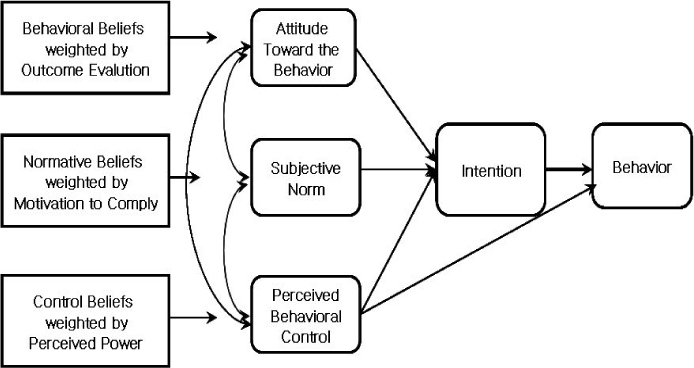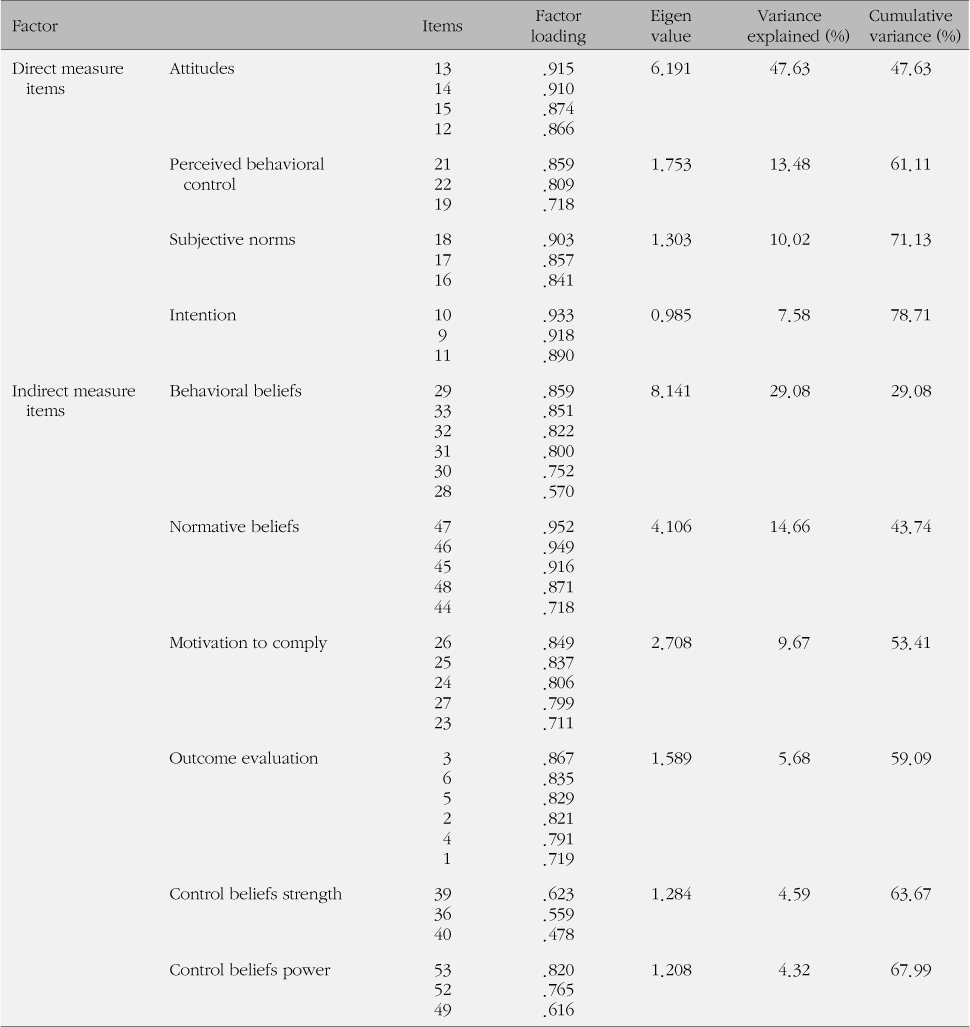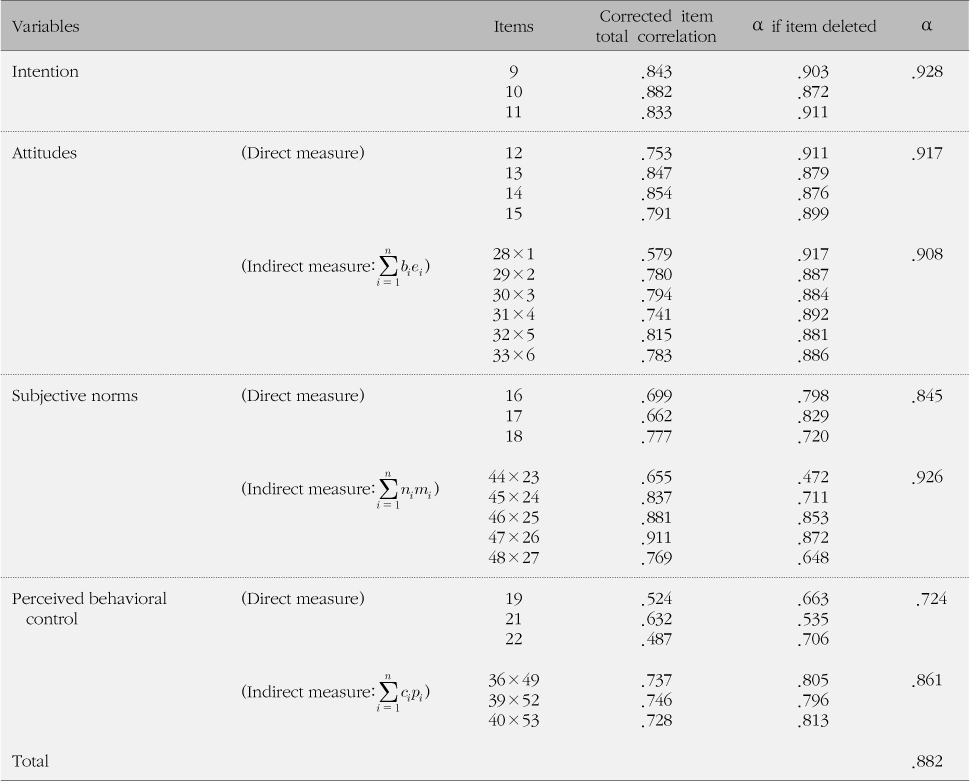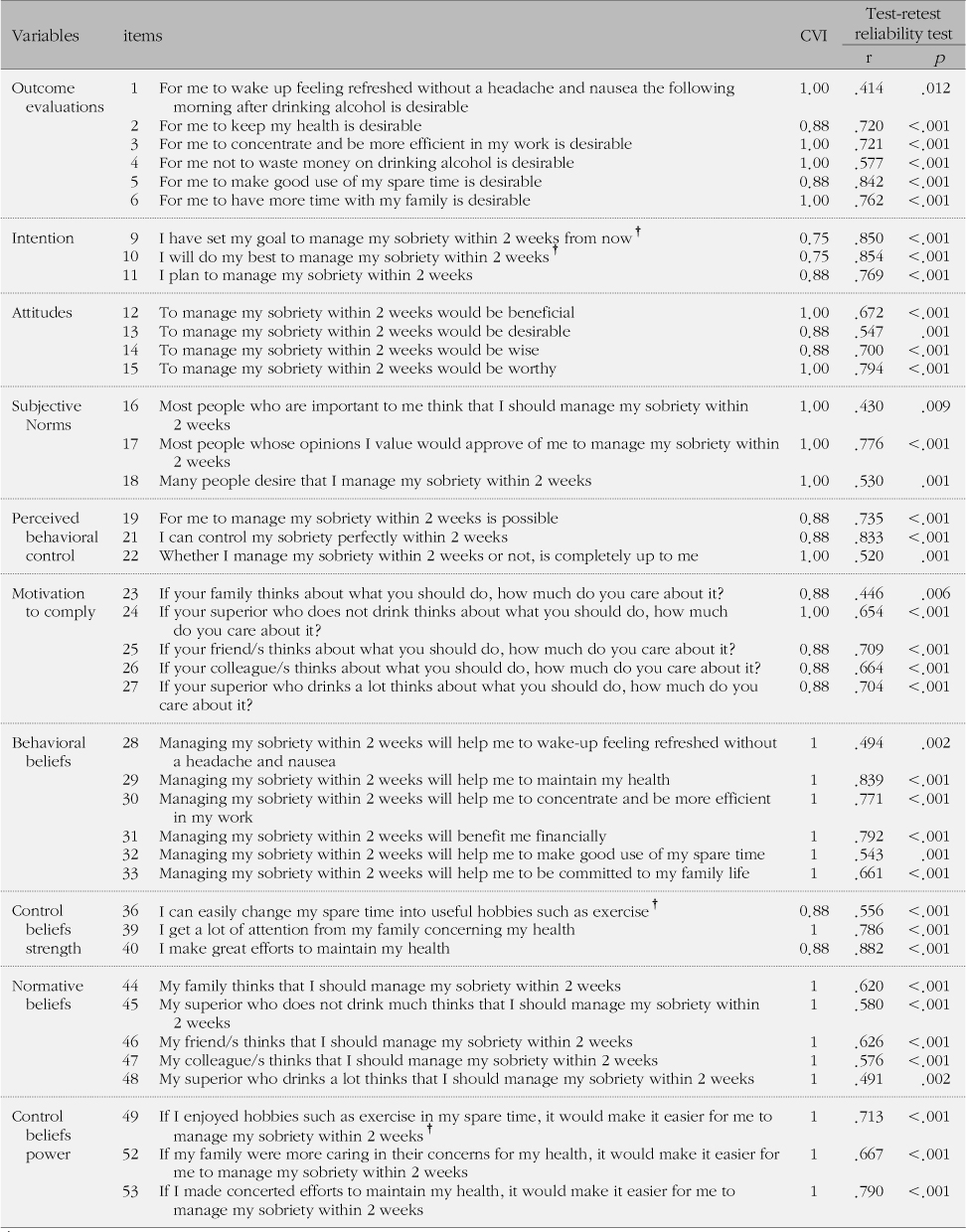Articles
- Page Path
- HOME > J Korean Acad Community Health Nurs > Volume 21(2); 2010 > Article
-
Original Article
- Constructing a Questionnaire on Male Workers' Sobriety Behavior: Based on Ajzen's Theory of Planned Behavior
- Inhyae Park, Younkyoung Kim
-
Journal of Korean Academy of Community Health Nursing 2014;21(2):156-168.
DOI: https://doi.org/10.12799/jkachn.2010.21.2.156
Published online: April 4, 2014
1Professor, College of Nursing, Chonnam National University, Chonnam National University Research Institute of Nursing Science, Korea.
2Researcher, Chonnam National University Research Institute of Nursing Science, Korea.
• Received: April 29, 2010 • Revised: June 14, 2010 • Accepted: June 16, 2010
© 2010 Korean Academy of Community Health Nursing
This is an Open Access article distributed under the terms of the Creative Commons Attribution Non-Commercial License (http://creativecommons.org/licenses/by-nc/3.0/) which permits unrestricted non-commercial use, distribution, and reproduction in any medium, provided the original work is properly cited.
- 560 Views
- 5 Download
- 4 Crossref
Abstract
-
Purpose
- The purpose of this study was to construct a questionnaire to assess male workers' sobriety behavior based on Ajzen's Theory of Planned Behavior (TPB).
-
Methods
- A primary questionnaire with 56 questions was constructed based on literature review and structured interview with male workers. The Content Validity Index (CVI) was evaluated by a group of experts, construct validity was tested by principle component analysis, and reliability was evaluated by Cronbach's α and the test-retest reliability test.
-
Results
- Fifty two questions showed higher than .8 of CVI. Four factors explained 78.71% of the total variance among items for sobriety intention and direct measure, and six factors explained 67.99% of the total variance among indirect measure items and those factors coincided with the variables of TPB in factor analysis. Cronbach's α of this questionnaire was .873 and the result of test-retest reliabilty test was relatively reliable. A total of 41 items with 7-point scale were constructed in the final version.
-
Conclusion
- This questionnaire was valid and reliable to measure sobriety behavior based on TPB in male workers. It can be useful to evaluate the result of a sobriety program for male workers.
-
This study was supported by a grant (CRI10001~CRI10090) Chonnam National University Hospital Institute of Clinical Medicine.
NOTES
- 1. Ajzen I. Behavioral interventions based on the theory of planned behavior 2010;Retrieved March 25, 2010. from http://www.people.umass.edu/aizen/pdf/tpb.intervention.pdf
- 2. Ajzen I. Attitudes, personality and behavior. 2nd ed. Berkshire: McGraw-Hill Education; 2006.
- 3. Ajzen I. Constructing a TpB questionnaire: Conceptual and methodological considerations 2002;Retrieved November 25, 2009. from http://www.people.umass.edu/aizen/pdf/tpb.measurement.pdf Nov. 25. 2009
- 4. Ajzen I. The theory of planned behavior. Organ Behav Hum Decis Process. 1991;50:179–211. Article
- 5. Ajzen I, Fishbein M. Understanding attitudes and predicting social behavior. Englewood Cliffs, N. J.: Plantice-Hall Inc; 1980.
- 6. Armitage CJ, Conner M. Efficacy of the theory of planned behavior: A meta-analytic review. Br J Soc Psychol. 2001;40:471–499. PubMed
- 7. Choi E. Selected alcohol consumption patterns of Korean adults. J Korean Alcohol Sci. 2006;7(2):17–28.
- 8. Choi W. The Korean drinking culture: De-sacredness of festivals becoming everyday life. Soc Hist. 2004;66:100–117.
- 9. Conner M, Warren R, Close S. Alcohol consumption and the theory of planned behavior: An examination of the cognitive mediation of past behavior. J Appl Soc Psychol. 1999;29(8):1676–1704.
- 10. Do EY, Doh BN. A comparative study on the problem drinking and job stress between employees who started drinking before and after. J Kyungpook Nurs Sci. 2004;8(1):17–30.
- 11. Francis JJ, Eccles MP, Johnston M, Walker A, Grimshaw J, Foy R, et al. Constructing questionnaires based on the theory of planned behaviour-A manual for health services researchers. Newcastle: University of Newcastle, Centre for Health Services Research; 2004.
- 12. Gmel G, Rehm J. Harmful alcohol use. Alcohol Res Health. 2003;27(1):52–62. PubMedPMC
- 13. Glanz K, Rimer BK, Viswanath K. Health behavior and health education. 4th ed. San Francisco, CA: Jossey-Bass; 2008.
- 14. Godin G, Kok G. The theory of planned behaviour: A review of its applications to health-related behaviours. Am J Health Promot. 1996;11(2):87–98. ArticlePubMedPDF
- 15. Godin G, Valois P, LePage I. The pattern of influence of perceived behavioral control upon exercising behavior: An application of Ajzen's theory of planned behavior. J Behav Med. 1993;16:81–102. ArticlePubMedPDF
- 16. Hanson MJ. The theory of planned behavior applied to cigarette smoking in african-american, puerto rican, and non-hispanic white teenage females. Nurs Res. 1997;46(3):155–162. ArticlePubMed
- 17. Jo K, Lee H, Lee Y. Development of an evaluation instrument for subjects related to death. J Korean Acad Nurs. 2006;36(1):74–83. ArticlePubMedPDF
- 18. Kim H. A study on motivation for alcohol use and drinking behavior of employees by social pressure. Korean J Occup Health Nurs. 2007;16(2):197–204.
- 19. Kweon G. Factors influencing drinking of employees: Focus on the white collar employees. Korean J Soc Welf. 2005;57(2):93–118.
- 20. Kwon IS, Lee GE, Kim GD, Kim YH, Park KM, Park HS, et al. Development of a critical thinking disposition scale for nursing students. J Korean Acad Nurs. 2006;36(6):950–958. ArticlePubMedPDF
- 21. Lee E, Ha S, Kang J. Development of testing of an instrument to measure family's emotional response toward physically restrained patients. J Korean Acad Nurs. 2008;38(4):629–638. ArticlePubMed
- 22. Lee H, Jekarl J. Survey on alcohol use of workers for developing employeeassistance program. Goyang: The Korean Alcohol Research Foundation; 2002.
- 23. Perney P, Bismuth M, Sigaud H, Picot MC, Jacquet E, Puche P, et al. Are preoperative patterns of alcohol consumption predictive of relapse after liver transplantation for alcoholic liver disease? Transpl Int. 2005;18(11):1292–1297. ArticlePubMed
- 24. Rehm J, Baliunas D, Borges GL, Graham K, Irving H, Kehoe T, et al. The relation between different dimensions of alcohol consumption and burden of disease: An overview. Addiction. 2010;105(5):817–843. ArticlePubMedPMC
- 25. Song HJ. Development of indicator for alcohol policy. Seoul: Korea Institute for Health and Social Affiars; 2005.
- 26. Tabachnick BG, Fidell LS. Using multivariate statistics. 3rd ed. New York: Harper Collins; 1996.
- 27. Wall AM, Hinson RE, MaKee SA. Alcohol outcome expectancies, attitudes toward drinking and the theory of planned behavior. J Stud Alcohol. 1998;59:409–419. ArticlePubMed
- 28. Waltz C, Strickland O, Lenz E. Measurement in nursing research. 2nd ed. Philadelphia: F.A. Davis; 1991.
- 29. WHO. Lexicon of alcohol and drug terms published by the World Health Organization 2010;Retrieved June 8, 2010. from http://www.who.int/substance_abuse/terminology/who_lexicon/en/index.html
- 30. Yoo HR. Korean undergraduate students' intention, attitude, perceived control, and social pressure for moderate drinking behavior. J Korean Community Nurs. 2000;11(2):347–357.
- 31. Yoon M. A study on the community based rehabilitation program to support of recovering process of alcoholics. Ment Health Soc Work. 1999;8:135–159.
Figure & Data
References
Citations
Citations to this article as recorded by 

- Controlled Drinking Behaviors Among Korean American and Korean Male Workers
Younkyoung Kim, John Lowe, OiSaeng Hong
Nursing Research.2021; 70(2): 114. CrossRef - An Analysis and Evaluation of the Theory of Planned Behavior Using Fawcett and DeSanto-Madeya's Framework
Sungwon Park, Hyewon Shin
Advances in Nursing Science.2021; 44(4): E141. CrossRef - Development of an Aggression Scale for Adolescents: Based on Ajzen’s Theory of Planned Behavior
Sook Jang, Hye Young Ahn
Child Health Nursing Research.2018; 24(4): 484. CrossRef - A Structural Model of Alcohol Abstinence Behavior among Patients with Chronic Liver Diseases
Tae Kyung Kim, Hye Sook Min
Korean Journal of Adult Nursing.2018; 30(1): 30. CrossRef

 KACHN
KACHN




 PubReader
PubReader Cite
Cite


